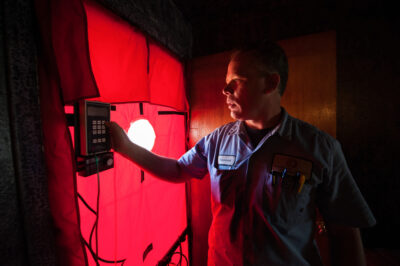Diagnostic tool to determine how much air is entering or escaping from your home

If you’re not sure where to start when trying to improve the comfort and efficiency of your home, a professional home energy audit will give you a roadmap.
An auditor will get an understanding of how you use your home, do a room-by-room examination, and an analysis of past energy bills. They may also use special equipment to detect sources of energy loss.
After the assessment, you’ll get a report with recommendations to reduce energy use and lower your utility bills.
Visit Energy Saver to learn more about professional home energy audits, and how to find an auditor near you.
Home energy professionals use a blower door as a diagnostic tool to determine the amount of air entering or leaving the home.
Professional energy assessors use blower door tests to help determine a home's airtightness.
These are some reasons for establishing the proper building tightness:
A blower door is a powerful fan that a trained energy professional temporarily mounts into the frame of an exterior doorway in your home. After calibrating the device, the fan pulls air out of the house, lowering the pressure inside. The higher outside air pressure flows through all unsealed gaps, cracks, and openings such as gaps, cracks, or wiring penetrations. If conditions do not allow for lowering the pressure in the home, the fan may also be operated in reverse, increasing air pressure inside the house.
While the blower test is being conducted, the analyst may use an infrared camera to examine the walls, ceilings, and floors to find specific locations where insulation is missing and air is leaking. The analyst may also use a nontoxic smoke pencil to detect air leaks in your home. These tests determine your home's air infiltration rate, recorded on a laptop or tablet.
The blower door test is part of your home's energy assessment. Your contractor may also operate the blower door while performing air sealing (a method known as blower door-assisted air sealing) and after measuring and verifying the level of air leakage reduction achieved.
Blower doors consist of a frame and flexible panel that fit in a doorway, a variable-speed fan, and a digital pressure gauge to measure the pressure differences inside and outside the home, which are connected to a device for measuring airflow, known as a manometer.
There are two types of blower doors: calibrated and uncalibrated. Auditors must use a calibrated door with several gauges that measure the air flowing out of the house through the fan.
Uncalibrated blower doors can only locate leaks in homes. They do not provide a method for determining the house's overall tightness.
The data from the calibrated blower door allow your contractor to quantify the amount of air leakage before installing air-sealing improvements and the reduction in leakage achieved after air-sealing is completed.
Your home energy professional will perform the blower door test, including a walk-through of your home, setting up the blower door, and conducting the test. The following steps will help prepare your home for a blower door test:
15 years of experience and In-Depth knowledge
Call us today at 786-800-4598 OR
Email us at [email protected]
Website: www.uhsmold.com
Copyright © 2023. All Rights Reserved.